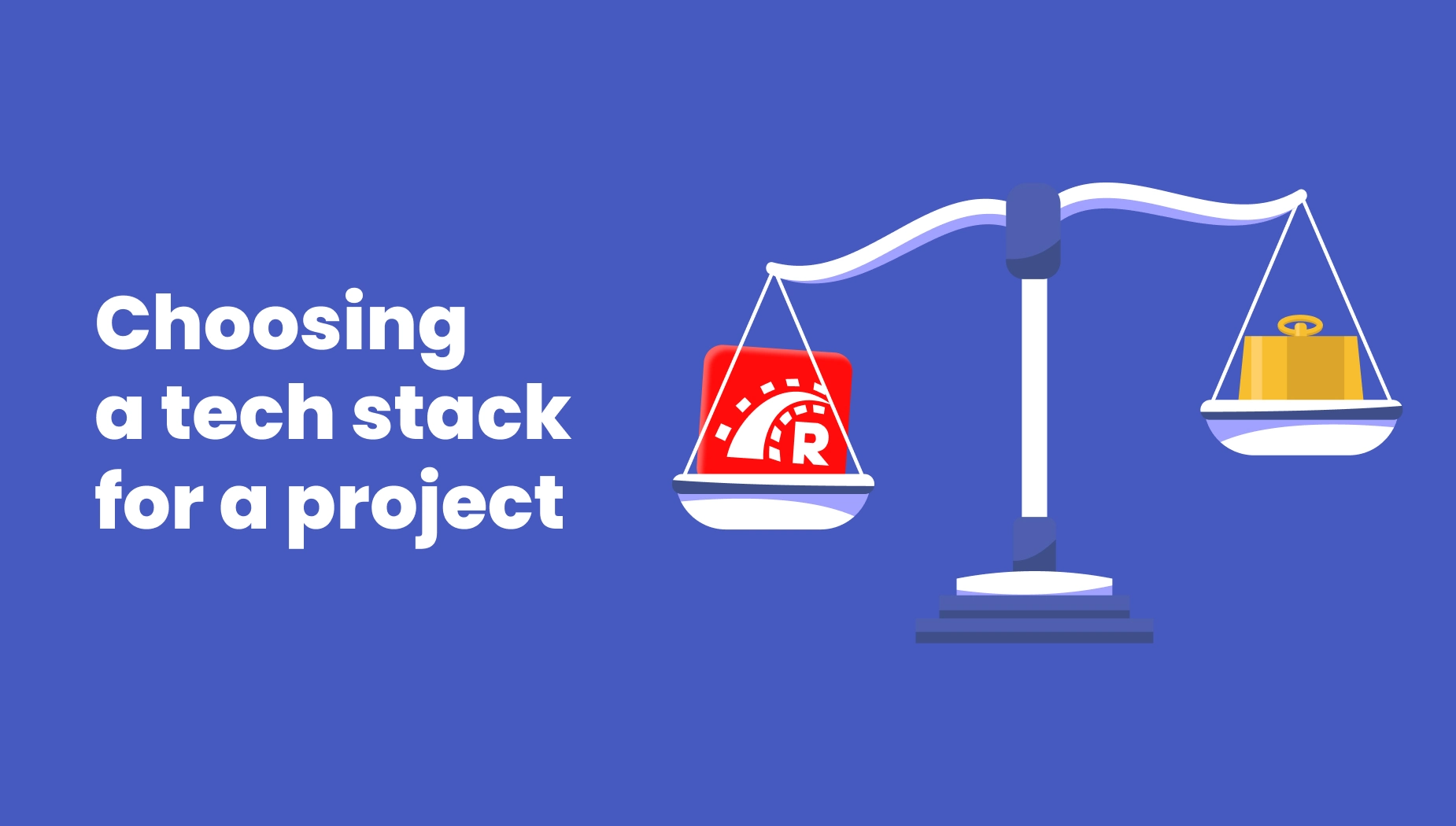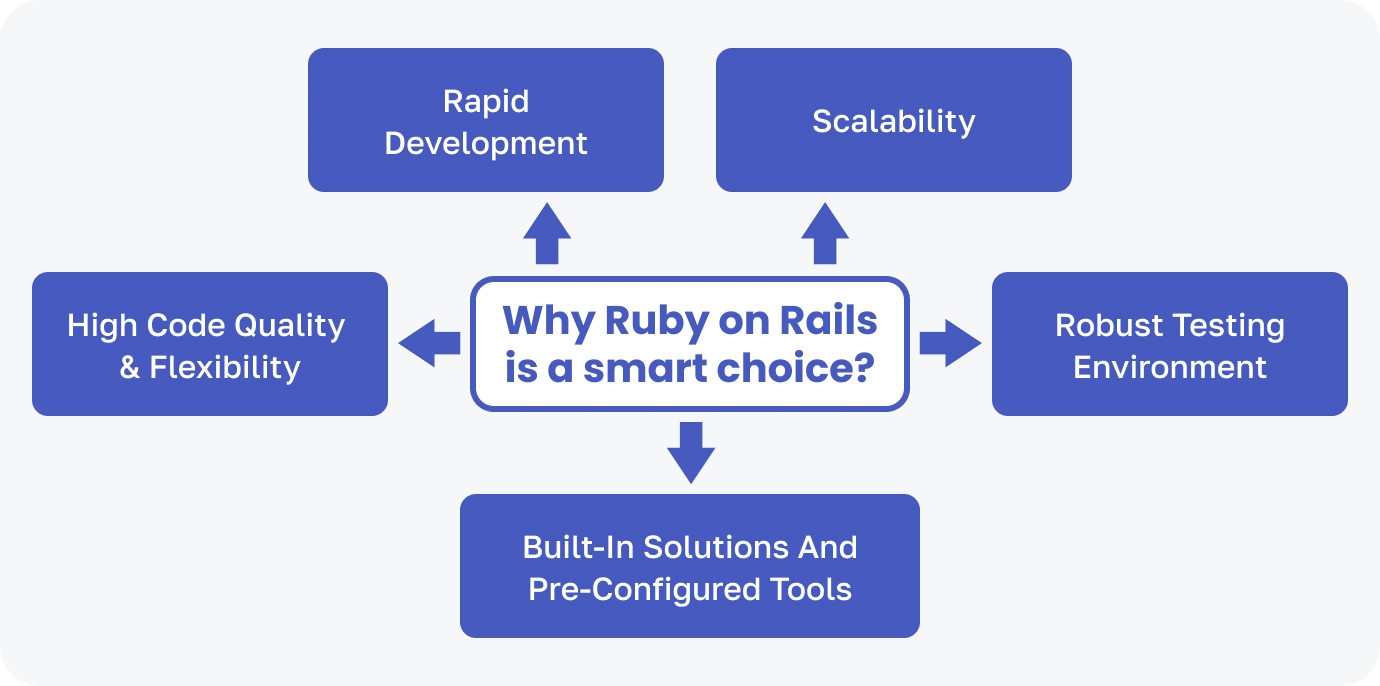Table of Contents
When starting a new project, your choice of tech stack can significantly impact your business’s success, scalability, and time to market. With numerous options available, making the right decision can feel overwhelming. Should you choose the latest technologies or rely on a tried-and-true stack like Ruby on Rails?
Paths to Success.
Different tech giants have followed various approaches when choosing their tech stacks. For example, Twitter was initially built on Ruby on Rails but later transitioned to a different platform; Airbnb stayed with Rails, successfully scaling it into the multi-billion-dollar company it is today.
The Lesson?
While your tech stack isn’t the sole determinant of success, it does affect how efficiently you can build, launch, and iterate on your product. If speed, quality, and a fast route to market are top priorities, Ruby on Rails is a strong contender, enabling you to deliver an MVP faster than most other frameworks.
Why Ruby on Rails Is Ideal for Web and Enterprise Apps?
Ruby on Rails offers several advantages that make it an ideal choice for web and enterprise applications:
Rapid Development
Thanks to its “convention-over-configuration” philosophy, Rails minimizes setup time, allowing you to focus on building your product quickly.
High Code Quality and Flexibility
Сombined with Ruby’s flexibility, Rails allows developers to create maintainable solutions or opt for faster, simpler implementations. This adaptability enables quick builds that streamline development without sacrificing functionality.
Robust Testing Environment
Rails comes with built-in testing tools, ensuring the reliability of your code and allowing you to spend more time adding value.
Scalability
Despite the myth that Rails doesn’t scale, many companies have proven it’s possible with the right infrastructure and experienced developers.
Built-in solutions and pre-configured tools
Rails provides built-in solutions and pre-configured tools, helping developers handle common web tasks. Unlike Node.js, which demands more custom configuration, Rails offers conventions and modules for faster development of secure applications.
These benefits make Ruby on Rails a strong contender for projects that require speed, flexibility, and high-quality output.
Who Chooses a Tech Stack?
Choosing the right tech stack isn’t just about the technology itself; it’s a collaborative effort involving the solution architect, client, and lead developer to ensure the stack aligns with both technical and business goals.
Solution Architect’s Role
A solution architect plays a crucial role in evaluating the project’s requirements, constraints, and long-term objectives. Before recommending a tech stack they consider factors such as the need for scalability, desired performance level, required security, possible scope of integrations, and the team’s expertise With their deep understanding of different technologies, they identify which stack offers the best balance of speed, flexibility, and cost-effectiveness.
In the case of Ruby on Rails, a solution architect might recommend it for projects that require rapid development, easy maintenance, and scalability while ensuring it aligns with the project’s future growth plans.
Client’s Role
The client’s involvement is equally important. Clients must communicate their business goals, target audience, expected traffic, budget, and long-term vision. Although they may not be familiar with all technical aspects, their insights on the project’s needs are crucial for guiding the decision. Clients should be open to solution architects’ recommendations but ask questions about how the chosen tech stack, such as Ruby on Rails, will meet their strategic objectives, support brand growth, and fit within their budget. This collaboration ensures the tech stack aligns with both technical and business requirements.
Lead Developer’s Role
The lead developer brings hands-on experience and practical insights into the tech stack selection process. They assess the feasibility of implementing the proposed stack, considering the existing team’s expertise, potential learning curves, and the day-to-day challenges of maintaining it. The lead developer bridges the gap between high-level architectural decisions and the realities of coding, ensuring that the chosen tech stack is theoretically sound practical, and efficient in execution. The lead developer’s experience with Ruby on Rails ensures that its conventions and features are used optimally, maximizing productivity and maintaining code quality.
The team chooses Ruby on Rails, or any tech stack, by working together to consider all perspectives and tailor it to meet the project’s needs.
It’s About the Team
Even the best tech stack can’t guarantee success without the right team behind it. A skilled developer can make Ruby on Rails shine, while an inexperienced team might struggle, regardless of the tools they use. That’s why having a team that understands Rails and how to build scalable, efficient applications is crucial.
Our Approach to Selecting a Tech Stack
When selecting a tech stack for a project, our approach always begins with the client’s preferences, if any exist. However, we ground such a critical decision in tangible criteria.
Therefore, the most reliable indicators for choosing a tech stack are the project’s functional and non-functional requirements, and the expertise available within our team and the broader company.
To ensure that the chosen technology aligns with the project’s needs, we typically present two options:
Simple, Reliable Solutions
These well-established tools have proven themselves – robust, stable, and capable of handling various tasks without unnecessary complexity. They are ideal for projects that prioritize stability and ease of use.
Complex, Highly Configurable Solutions
For projects requiring fine-tuning and deep customization, we consider more intricate technologies that offer flexibility but may come with a steeper learning curve. These solutions are suitable for projects with unique or highly specialized requirements.
Regardless of the type of website envisioned, we often recommend starting with Ruby on Rails due to its simplicity, reliability, and proven versatility across various projects. One of our core principles is to avoid adding complexity to areas of the project that don’t require it to solve the customer’s problem. This approach keeps the project streamlined and focused, therefore we build a solid foundation without unnecessary overhead.
When clients have questions or express doubts about this choice, we provide a well-reasoned explanation. The advantages we present — such as rapid development, flexibility, and proven success — have consistently proven convincing, allowing clients to trust that this choice is right.
Prioritizing Non-Functional Requirements
While many projects focus on incorporating as many features as possible in the early stages, we prioritize investing in non-functional requirements. This often means dedicating additional effort to the project’s infrastructure. We adopt an “Infrastructure as Code” (IaC) approach and ensure deployment and production environments are structured and automated.
Although this strategy may require a slightly larger initial budget for deployment preparation, it establishes a stable foundation for the project’s future growth, yielding long-term benefits.
JetRuby Academy: Training the Next Generation of Ruby Engineers
JetRuby Academy’s training foundation is built on a rigorous selection process and a dedication to delivering highly qualified engineers to clients. The Academy was created to train Ruby engineers, starting with entry-level students. It focuses on individuals with foundational technical knowledge eager to gain practical, hands-on experience.
Throughout their training, candidates explore the nuances of programming and work on real-world projects, guided by seasoned Ruby practitioners. By the end of the program, students complete and defend their graduation project. This mentor-apprentice model ensures that our engineers gain practical, real-world skills.
Proven Technology, Proven Results.
The debate over the “best” tech stack will continue, but when it comes to delivering high-quality products quickly and efficiently, Ruby on Rails remains a top contender. A passionate community supports this proven, reliable framework. Whether you’re building a web app, enterprise solution, or MVP, Rails offers a blend of speed, scalability, and maintainable code that’s hard to beat.
By leveraging the skills of a well-trained team, such as those from the JetRuby Academy, and ensuring a collaborative approach between solution architects, clients, and lead developers, you guarantee a tech stack that’s not just theoretically sound but practical and effective for your project’s success.
So, while the latest technologies may be tempting, sticking with a tool that has stood the test of time offers real value. Ruby on Rails isn’t just a safe choice – it’s a smart one that could be the foundation for your next successful project.
Ready to build something amazing? Let’s get started.





